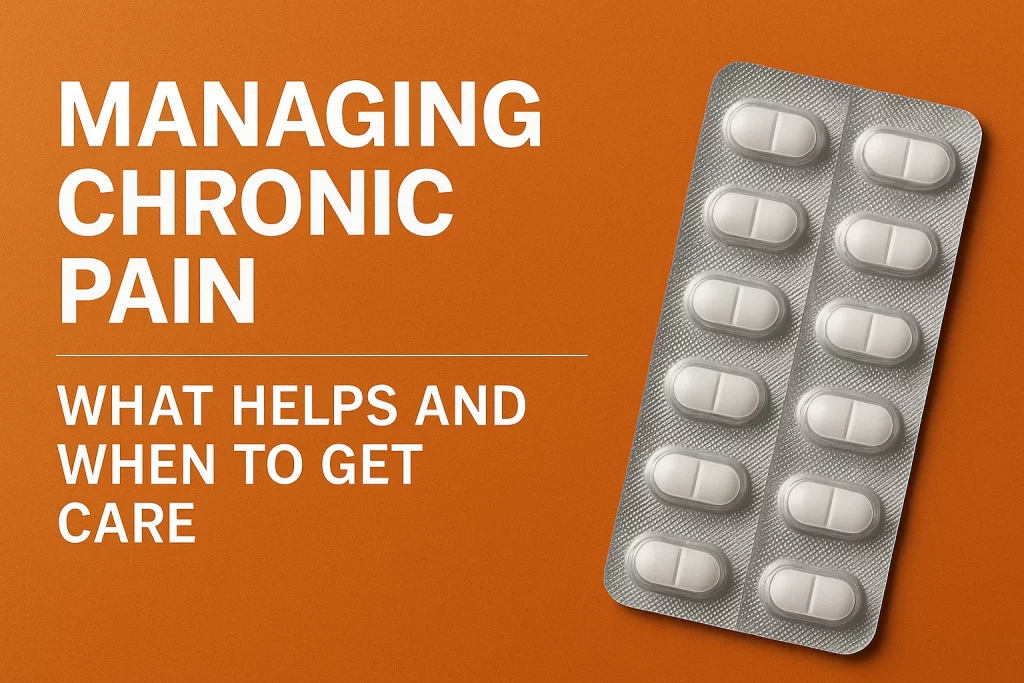Living with ongoing or chronic pain can affect everything from your sleep and mood to your ability to work and enjoy daily life. For many people, the pain becomes something they simply learn to live with, but it doesn’t have to be that way.
This guide breaks down common causes of persistent pain, the treatment options that actually work, and when it might be time to get professional support.
What Is Ongoing or Chronic Pain?
Pain is considered “chronic” when it lasts for more than 12 weeks, even after the original cause (such as an injury or infection) has healed.
It can be:
- Musculoskeletal (back, joints, muscles)
- Neuropathic (nerve-related)
- Inflammatory (arthritis or autoimmune conditions)
- Functional (no clear physical cause, e.g. fibromyalgia)
Chronic pain doesn’t always show up in scans or tests, but that doesn’t mean it isn’t real.
Common Causes of Ongoing Pain
| Condition | Typical Pain Location | Common Symptoms |
|---|---|---|
| Osteoarthritis | Joints (knees, hips, hands) | Stiffness, aching, reduced movement |
| Sciatica | Lower back, legs | Shooting or burning nerve pain |
| Fibromyalgia | Widespread | Tender points, fatigue, brain fog |
| Migraines | Head | Throbbing pain, light sensitivity, nausea |
| Endometriosis | Pelvis, abdomen | Period pain, bloating, pain during sex |
Pain can also linger after surgery, injuries, or infections like shingles.
What Actually Helps?
Pain is personal, so treatments often involve trial and error. The best approach is often multimodal — combining more than one strategy:
1. Medication
- Paracetamol or ibuprofen for mild to moderate pain
- Codeine or tramadol (short-term use only)
- Neuropathic medications like amitriptyline or pregabalin for nerve pain
- Topical treatments (gels, creams, patches)
Private prescriptions for pain relief are available through our pharmacy. You can check your options here.
2. Physical Therapies
- Physiotherapy to strengthen muscles and improve mobility
- Stretching and targeted exercises
- Hydrotherapy and massage for joint and muscle pain
3. Lifestyle Changes
- Weight loss can ease pressure on joints
- Staying active helps reduce stiffness and improve pain tolerance
- Stress management (yoga, breathing exercises, mindfulness)
4. Talking Therapies
Cognitive Behavioural Therapy (CBT) can help you manage how pain affects your mental wellbeing. Pain is a physical experience, but it’s closely linked to emotions, thoughts and stress levels.
5. Medical Interventions
- Steroid injections for joint inflammation
- Nerve blocks for specific nerve pain
- Specialist referrals for long-term management plans
When Should You Get Help?
You don’t need to live in pain or wait for it to get worse before speaking to someone.
Speak to a healthcare provider if:
- Pain has lasted more than 12 weeks
- Over-the-counter medication is not helping
- Pain is affecting your work, sleep, or daily routine
- You notice new symptoms or worsening pain
For private support, you can see our pain relief options here and get personalised advice quickly and discreetly.
Final Thoughts
Living with pain is not something you have to just accept. From simple medications to expert support and targeted therapies, there are many ways to manage pain effectively and improve your quality of life.
The first step is recognising that help is available and that your pain deserves attention.

